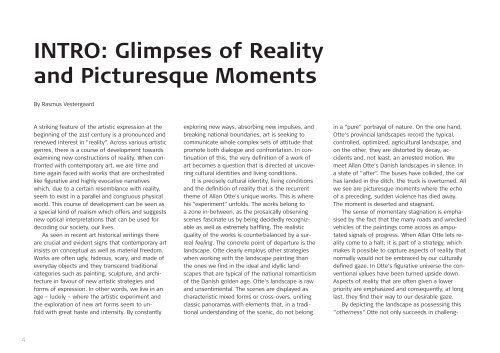Allan_Otte_Landskabsmaleri_2008 - 72 sider - 15 - TIFF ... - Allan Otte
Allan_Otte_Landskabsmaleri_2008 - 72 sider - 15 - TIFF ... - Allan Otte
Allan_Otte_Landskabsmaleri_2008 - 72 sider - 15 - TIFF ... - Allan Otte
You also want an ePaper? Increase the reach of your titles
YUMPU automatically turns print PDFs into web optimized ePapers that Google loves.
4<br />
INTRO: Glimpses of Reality<br />
and Picturesque Moments<br />
By Rasmus Vestergaard<br />
A striking feature of the artistic expression at the<br />
beginning of the 21st century is a pronounced and<br />
renewed interest in ”reality”. Across various artistic<br />
genres, there is a course of development towards<br />
examining new constructions of reality. When confronted<br />
with contemporary art, we are time and<br />
time again faced with works that are orchestrated<br />
like fi gurative and highly evocative narratives<br />
which, due to a certain resemblance with reality,<br />
seem to exist in a parallel and congruous physical<br />
world. This course of development can be seen as<br />
a special kind of realism which offers and suggests<br />
new optical interpretations that can be used for<br />
decoding our society, our lives.<br />
As seen in recent art historical writings there<br />
are crucial and evident signs that contemporary art<br />
insists on conceptual as well as material freedom.<br />
Works are often ugly, hideous, scary, and made of<br />
everyday objects and they transcend traditional<br />
categories such as painting, sculpture, and architecture<br />
in favour of new artistic strategies and<br />
forms of expression. In other words, we live in an<br />
age – luckily – where the artistic experiment and<br />
the exploration of new art forms seem to unfold<br />
with great haste and intensity. By constantly<br />
exploring new ways, absorbing new impulses, and<br />
breaking national boundaries, art is seeking to<br />
communicate whole complex sets of attitude that<br />
promote both dialogue and confrontation. In continuation<br />
of this, the very defi nition of a work of<br />
art becomes a question that is directed at uncovering<br />
cultural identities and living conditions.<br />
It is precisely cultural identity, living conditions<br />
and the defi nition of reality that is the recurrent<br />
theme of <strong>Allan</strong> <strong>Otte</strong>’s unique works. This is where<br />
his ”experiment” unfolds. The works belong to<br />
a zone in-between, as the prosaically observing<br />
scenes fascinate us by being decidedly recognizable<br />
as well as extremely baffl ing. The realistic<br />
quality of the works is counterbalanced by a surreal<br />
feeling. The concrete point of departure is the<br />
landscape. <strong>Otte</strong> clearly employs other strategies<br />
when working with the landscape painting than<br />
the ones we fi nd in the ideal and idyllic landscapes<br />
that are typical of the national romanticism<br />
of the Danish golden age. <strong>Otte</strong>’s landscape is raw<br />
and unsentimental. The scenes are displayed as<br />
characteristic mixed forms or cross-overs, uniting<br />
classic panoramas with elements that, in a traditional<br />
understanding of the scenic, do not belong<br />
in a ”pure” portrayal of nature. On the one hand,<br />
<strong>Otte</strong>’s provincial landscapes record the typical,<br />
controlled, optimized, agricultural landscape, and<br />
on the other, they are distorted by decay, accidents<br />
and, not least, an arrested motion. We<br />
meet <strong>Allan</strong> <strong>Otte</strong>’s Danish landscapes in silence. In<br />
a state of ”after”. The buses have collided, the car<br />
has landed in the ditch, the truck is overturned. All<br />
we see are picturesque moments where the echo<br />
of a preceding, sudden violence has died away.<br />
The moment is deserted and stagnant.<br />
The sense of momentary stagnation is emphasised<br />
by the fact that the many roads and wrecked<br />
vehicles of the paintings come across as amputated<br />
signals of progress. When <strong>Allan</strong> <strong>Otte</strong> lets reality<br />
come to a halt, it is part of a strategy, which<br />
makes it possible to capture aspects of reality that<br />
normally would not be embraced by our culturally<br />
defi ned gaze. In <strong>Otte</strong>’s fi gurative universe the conventional<br />
values have been turned upside down.<br />
Aspects of reality that are often given a lower<br />
priority are emphasized and consequently, at long<br />
last, they fi nd their way to our desirable gaze.<br />
By depicting the landscape as possessing this<br />
“otherness” <strong>Otte</strong> not only succeeds in challeng-


